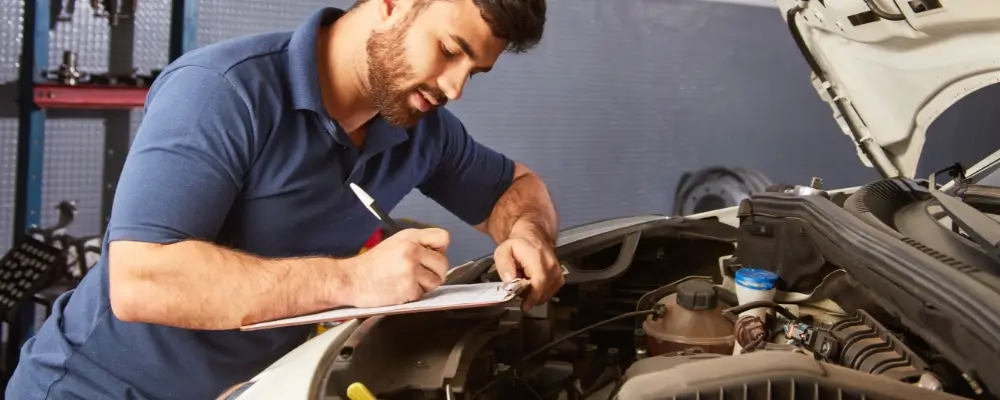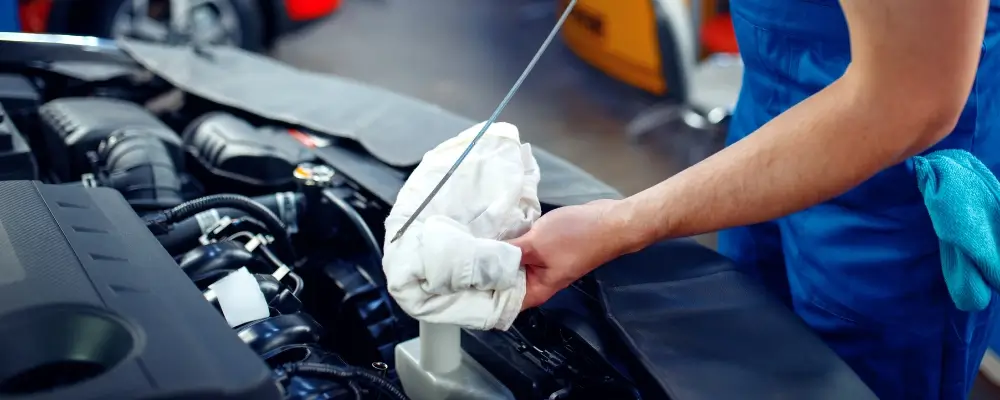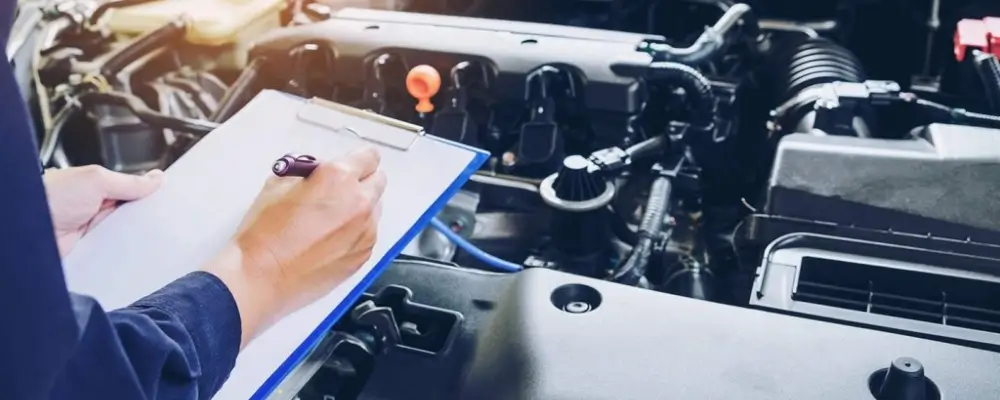Hitting the road with a faulty car is both dangerous and can lead to unexpected breakdowns. That’s why regular vehicle safety inspections are crucial. These inspections ensure that your car is road-ready, minimizing the risk of accidents while offering peace of mind.
Let’s dive into what vehicle safety inspections are and what mechanics will be looking at under the hood, on the tires, and beyond.
What’s Vehicle Safety Inspection?
A vehicle safety inspection is a regulated procedure that ensures a vehicle is safe for operation on public roads. This inspection is typically conducted by licensed professionals at designated inspection stations, which can include Department of Motor Vehicles (DMV) locations, authorized auto repair shops, or other certified locations, depending on the state or country’s regulations. The primary goal of a vehicle safety inspection is to check that a vehicle’s essential systems and components meet the minimum safety standards set by the governing body.
The specifics of what is included in a vehicle safety inspection can vary significantly from one jurisdiction to another. However, the core focus is generally on the vehicle’s critical safety features, including brakes, tires, lights, steering, suspension, mirrors, windshield wipers, and seat belts. Some inspections may also include checks on the vehicle’s emissions system to ensure it complies with environmental standards.
Vehicle safety inspections can be mandatory at various times, such as:
- Annually or biennially: Some states or countries require vehicle owners to undergo regular safety inspections to maintain their vehicle registration.
- Upon sale or transfer: In certain jurisdictions, a vehicle must pass a safety inspection before it can be sold or transferred to a new owner.
- For commercial vehicles: Commercial vehicles often have stricter and more frequent inspection requirements to ensure public safety.
The inspection process aims to identify and mitigate potential hazards that could endanger the driver, passengers, and other road users. Vehicles that fail to meet the required standards may need to undergo repairs and be re-inspected before they can be driven legally. Vehicle owners are usually advised to familiarize themselves with their specific state or country’s inspection requirements and schedule to ensure compliance and maintain road safety.

What Is Checked During a Vehicle Safety Inspection?
During a vehicle safety inspection, a licensed car technician examines various components of your car to ensure it is safe to drive on the road. The inspection typically covers:
1. Tires
- Tread Depth: Inspectors measure the tread depth to ensure it meets the minimum legal requirement, which is typically 2/32 of an inch. Adequate tread depth is crucial for maintaining traction on the road, especially in wet conditions.
- Condition: They look for signs of wear and damage such as cuts, bulges, or objects embedded in the tire that could lead to a blowout. Dry rot (cracking due to age and sun exposure) and sidewall damage are also checked.
- Spare Tire: The condition and readiness of the spare tire are verified, ensuring it can be used in an emergency.
2. Brakes
- Pads and Rotors: The wear on brake pads and rotors is assessed. Excessively worn brake pads or rotors can significantly reduce braking efficiency and safety.
- Fluid Leaks: The brake system is checked for leaks, which can lead to brake failure.
- Emergency Brake: The functionality of the emergency (parking) brake is tested to ensure it can securely hold the vehicle on an incline.
3. Lights
- Functionality: All external lights, including headlights (both high and low beam), taillights, brake lights, turn signals, hazard lights, and license plate lights, must work correctly.
- Brightness and Color: Lights must be of the correct color (e.g., red for brake lights, white for reverse lights) and brightness to ensure visibility for the driver and to communicate effectively with other road users.
4. Windshield
- Visibility: The windshield should not have any cracks or chips that obstruct the driver’s view.
- Integrity: Inspectors check for loose seals or damage that could allow water to enter the vehicle or cause the windshield to fail.
5. Windshield Wipers
- Efficiency: Wipers must effectively clear water, snow, and debris from the windshield without leaving streaks that could impair visibility.
- Condition: The rubber on the wiper blades is checked for signs of wear or damage.
6. Mirrors
- Presence and Condition: Both side mirrors and the rearview mirror must be present, securely attached, and free from cracks or damage that could impair visibility.
- Adjustability: Mirrors should be adjustable to allow the driver to have a clear view of the vehicle’s rear and sides.
7. Seat Belts
- Functionality: Seat belts are tested to ensure they lock and retract properly, providing effective restraint in the event of a crash.
- Condition: The webbing, buckles, and retractors are checked for wear, damage, or malfunction.
8. Steering and Alignment
- Steering Play: Excessive play or looseness in the steering wheel can indicate worn steering components, affecting vehicle control.
- Component Wear: The inspection includes checking for wear or damage to steering parts that could compromise vehicle handling.
9. Suspension
- Shock Absorbers: Inspectors check for leaking, damaged, or worn shock absorbers that could affect the vehicle’s stability and comfort.
- Suspension Components: Springs, struts, and other suspension parts are examined for damage or excessive wear that could impact the vehicle’s ability to absorb road irregularities.
These detailed checks are designed to ensure that all critical aspects of the vehicle’s safety and operational integrity are maintained, thereby protecting the driver, passengers, and other road users. Regular inspections help identify and rectify potential issues before they lead to more significant problems or accidents.

Vehicle Inspection Procedure
The vehicle inspection procedure can vary by jurisdiction, but it generally follows a structured process to ensure that all critical safety and emissions components of a vehicle meet the specified standards. Below is a generalized overview of the typical steps involved in a vehicle safety inspection procedure:
1. Documentation Check
- The inspector may start by verifying the vehicle’s documentation, including registration, proof of insurance, and any previous inspection reports. This step ensures the vehicle is legally registered and eligible for inspection.
2. Exterior Inspection
- Lights: Headlights, taillights, brake lights, turn signals, and emergency flashers are checked for proper operation, alignment, and brightness.
- Tires: The condition of the tires, including tread depth and signs of wear or damage, is assessed. The spare tire may also be checked.
- Body: The vehicle’s body is inspected for any damage or modifications that could affect safety, such as sharp edges or illegal modifications.
3. Brake System Inspection
- The brake system, including the brake pads, rotors, drums, and lines, is inspected for wear and leaks. The parking brake is also tested for proper function.
4. Steering and Suspension
- The steering system and suspension components are checked for wear and proper operation. This may include testing the steering wheel for excessive play and inspecting shock absorbers for leaks.
5. Under the Hood
- Engine Components: Inspectors may check for leaks, the condition of belts and hoses, and overall engine health.
- Fluid Levels: Fluid levels, including oil, brake fluid, coolant, and transmission fluid, are checked to ensure they are within the recommended range.
- Battery and Electrical: The battery’s condition and the electrical system’s operation, including the alternator’s output, are assessed.
6. Interior Inspection
- seat belts: All seat belts are checked for proper function, wear, and damage.
- Mirrors: The condition and proper placement of rearview and side mirrors are verified.
- Windshield Wipers: Wipers and washers are tested to ensure they can effectively clear the windshield.
- Horn: The horn is tested for functionality.
7. Emissions Testing (if applicable)
- In jurisdictions where emissions testing is part of the vehicle inspection, the vehicle’s exhaust system is tested for pollutants to ensure it meets environmental standards.
8. Road Test (if required)
- Some inspections may include a road test to observe the vehicle’s operation, including braking, steering, and handling characteristics.
9. Inspection Report
- Upon completion of the inspection, the inspector provides a report detailing any deficiencies or issues that must be addressed. If the vehicle passes all required tests, it receives a pass certificate or sticker indicating compliance. If it fails, the vehicle owner will be informed of the specific reasons for failure and may need to repair the vehicle and have it re-inspected.
It’s important for vehicle owners to prepare for the inspection by ensuring their vehicle is in good condition and addressing any known issues beforehand. Regular maintenance can help avoid inspection failures and ensure the vehicle remains safe and roadworthy.

What Are The Three Types Of Vehicle Inspection?
Vehicle inspections can be categorized into three primary types, each serving a distinct purpose and focusing on different aspects of vehicle safety, compliance, and performance. These types are:
1. Safety Inspection
- Focus: Ensuring that the critical safety systems of your vehicle are in good working order, covering brakes, lights, tires, steering, suspension, etc.
- Reason: Usually mandated by state or local government for vehicle operation and registration. Can be required annually, bi-annually, or less frequently.
2. Emissions Inspection
- Focus: Testing the tailpipe emissions of your vehicle to ensure it meets environmental standards set by the EPA or your state’s governing body.
- Reason: Required in certain states and regions to reduce air pollution. Often combined with safety inspections.
3. Pre-Purchase Inspection
- Focus: A comprehensive examination of a used vehicle’s condition before you buy it. This goes beyond a basic safety inspection and can include paint quality, interior wear and tear, frame damage checks, and an in-depth mechanical analysis.
- Reason: To help buyers make an informed decision about the used vehicle they are considering. Pre-purchase inspections are usually not mandatory but strongly recommended to avoid purchasing a vehicle with hidden problems.
Important Notes:
- Variations between states: The specific requirements and frequency of inspections vary between states. It’s important to check your local DMV or governing body to understand what’s required in your location.
- Additional Inspection Types: There can be specialized inspections for commercial vehicles, salvage title vehicles, or vehicles that have undergone significant modifications.
Conclusion
Don’t think of vehicle safety inspections as just another chore or expense – consider them an investment in your safety and the well-being of others on the road. By proactively maintaining your vehicle and addressing potential issues spotted during inspections, you’ll gain peace of mind, avoid costly repairs down the line, and could even prevent an accident. Stay informed about the inspection requirements in your state, and make those appointments a priority to keep yourself and your vehicle road-ready.

